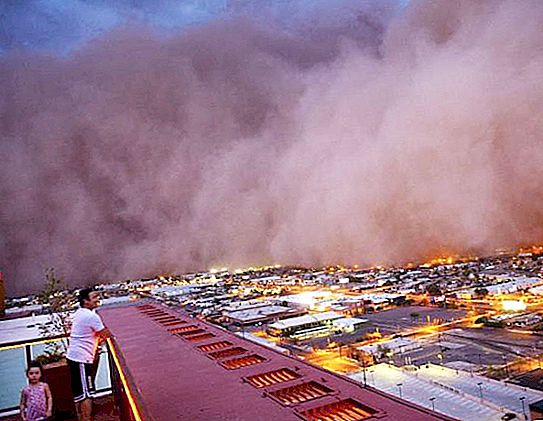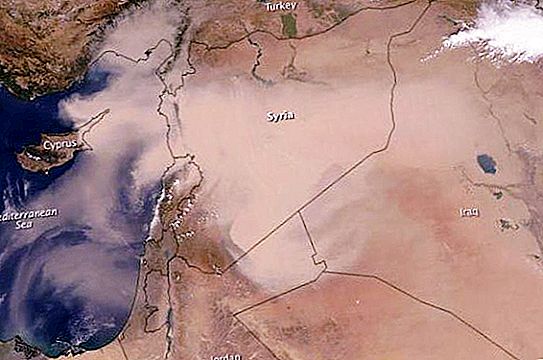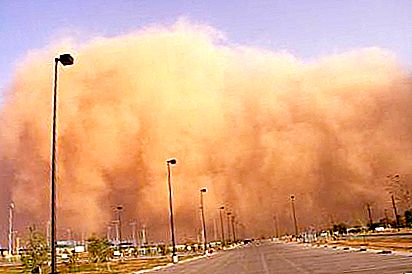These climatic phenomena make a significant contribution to the pollution of the earth's atmosphere. It is one of the many incredible natural phenomena to which scientists quickly found a simple explanation.
These adverse climatic events are dust storms. They will be described in more detail in the following article.
Definition
A dusty or sandstorm is a phenomenon of the transfer of a huge amount of sand and dust by strong winds, which is accompanied by a sharp deterioration in visibility. As a rule, such phenomena originate on land.
These are the arid regions of the planet, from where powerful air clouds of dust carry the air currents into the ocean. Moreover, presenting a considerable danger to humans mainly on land, they nevertheless greatly worsen the transparency of atmospheric air, making it difficult to observe the surface of the ocean from space.
Causes of dust storms
The thing is in the terrible heat, due to which the soil dries out strongly and then in the surface layer breaks up into microparticles picked up by a strong wind.
But dust storms begin at certain critical values of wind speeds, depending on the topography and soil structure. Mostly they start at wind speeds in the range of 10-12 m / s. And on loessial soils, weak dust storms occur in summer even at speeds of 8 m / s, less often at 5 m / s.
Behavior
The duration of the storms varies from minutes to several days. Most often, the time is calculated in hours. For example, an 80-hour storm was recorded in the Aral Sea region.
After the disappearance of the causes of the described phenomenon, the raised dust from the surface of the earth remains in the air in suspension for several hours, possibly a day. In these cases, its enormous masses are carried by air currents for hundreds and even thousands of kilometers. The dust carried by the wind at large distances from the source is called the advective haze.

Tropical air masses carry this haze to the southern part of Russia and all of Europe from Africa (its northern regions) and the Middle East. And western flows often carry such dust from China (center and north) on the Pacific coast, etc.
Color
Dust storms have the most diverse color, which depends on the structure of the soil and its color. There are storms of the following colors:
- black (black soil of the southern and southeastern regions of the European part of Russia, Orenburg region and Bashkiria);
- yellow and brown (typical of the USA and Central Asia - loam and sandy loam);
- red (red-colored, stained with iron oxides soils of the desert areas of Afghanistan and Iran;
- white (salt marshes of some regions of Kalmykia, Turkmenistan and the Volga region).
Geography of storms
Dust storms occur in completely different places on the planet. The main habitat are semi-deserts and deserts of tropical and temperate climatic zones, with both earth hemispheres.
Usually the term "dust storm" is used when it occurs over loamy or clay soil. When it occurs in sandy deserts (for example, in the Sahara, Kyzylkum, Karakum, etc.), and, besides the smallest particles, the wind carries millions of tons of air and larger particles (sand), the term "sandstorm" is already used.
Dust storms often occur in the Balkhash region and the Aral Sea region (southern Kazakhstan), in the western part of Kazakhstan, on the Caspian coast, in Karakalpakstan and in Turkmenistan.
Where are dust storms in Russia? Most often they are observed in the Astrakhan and Volgograd regions, in Tuva, Kalmykia, as well as in the Altai and Transbaikal territories.

During periods of prolonged drought, storms can develop (not every year) in the forest-steppe and steppe zones of Chita, Buryatia, Tuva, Novosibirsk, Orenburg, Samara, Voronezh, Rostov regions, Krasnodar, Stavropol territories, in Crimea, etc.
The main sources of dusty haze near the Arabian Sea are the deserts of the Arabian Peninsula and the Sahara. Less damage in these places is caused by the storms of Iran, Pakistan and India.
Chinese storms carry dust into the Pacific Ocean.
Environmental effects of dust storms
The described phenomena are capable of moving huge dunes and carrying large volumes of dust in such a way that the front can be represented as a dense and high wall of dust (up to 1.6 km.). Storms coming from the Sahara desert are known as “samum”, “hamsin” (Egypt and Israel) and “habub” (Sudan).

For the most part in the Sahara, storms occur in the Bodell Basin and at the junction of the borders of Mali, Mauritania and Algeria.
It should be noted that over the past 60-odd years the number of dusty Saharan storms has increased by about 10 times, which caused a significant decrease in the thickness of the surface soil layer in Chad, Niger, and Nigeria. For comparison, it can be noted that in Mauritania in the 60s of the last century, only two dust storms occurred, and today there are 80 storms per year.
Environmental scientists believe that an irresponsible attitude to the arid regions of the Earth, in particular, ignoring the crop rotation system, is steadily leading to an increase in desert areas and a change in the climatic state of planet Earth at the global level.
Ways to fight
Dust storms, like many other natural phenomena, do great harm. In order to reduce and even prevent their negative consequences, it is necessary to analyze the features of the localities - topography, microclimate, the direction of the prevailing winds here, and take appropriate measures that will reduce the wind speed at the earth's surface and increase the adhesion of soil particles.
To reduce the speed of the wind, certain events are held. Everywhere systems of wind-shelter backstage and forest belts are created. A considerable effect for increasing the adhesion of soil particles is provided by non-subsurface plowing, left stubble, crops of perennial grasses, strips of perennial grasses interspersed with crops of annual crops.
Some of the most famous sand and dust storms
For example, we offer you a list of the most famous sand and dust storms:
- In 525 BC e., according to the testimony of Herodotus, in the Sahara during the sandstorm killed 50 thousandth army of the king of Persia Cambyses.
- In 1928, in Ukraine, a terrible wind raised more than 15 million tons of black soil from an area of 1 million km², the dust of which was transferred to the Carpathian region, Romania and Poland, where it settled.
- In 1983, a severe storm in northern Victoria in Australia covered the city of Melbourne.
- In the summer of 2007, a severe storm occurred in Karachi and in the territories of the provinces of Baluchistan and Sindh, and heavy rains following it led to the death of about 200 people.
- In May 2008, 46 people were killed in a sand storm in Mongolia.
- In September 2015, a terrible “Sharav” (sandstorm) swept over a larger area of the Middle East and North Africa. Israel, Egypt, Palestine, Lebanon, Jordan, Saudi Arabia and Syria were badly affected. There were human casualties.






